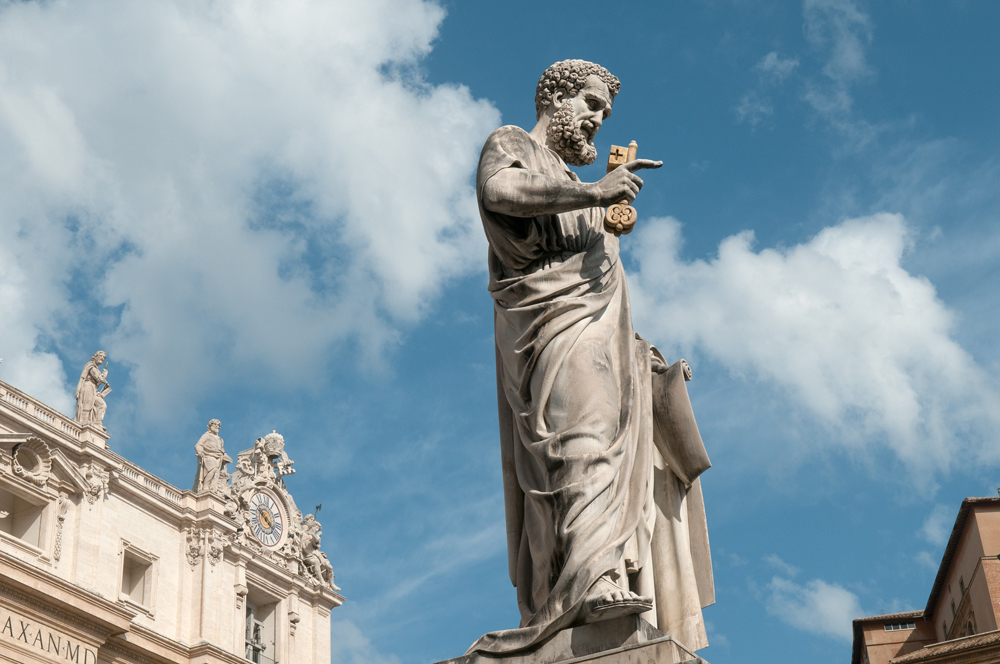
The household of God . . . is the church of the living
God, the pillar and foundation of truth.
1 Timothy 3:15
THE PILLAR AND FOUNDATION OF TRUTH
The Catholic Church presents God’s truth—not just one set of opinions about theology and morality, but the teachings of Christ as revealed in Scripture and passed down through the apostles and their successors. When we embrace the Catholic Church, we allow ourselves to be immersed in truth and align our lives accordingly.
This is not to say that everything every Catholic says and does is true. Every individual—woman and man, even the pope—is human and thus sinful and will make mistakes, even grave ones. But we can count on the Catholic Church to teach the truth.
It is important to understand our faith. We must be sure that the information we receive is true to Catholic teachings. We can do this by referring to the Bible, the Catechism of the Catholic Church, and other resources that the Catholic Church approves. A nihil obstat and imprimatur on the copyright page of a book indicates that the work agrees with Catholic teaching.
SCRIPTURE, TRADITION, AND THE MAGISTERIUM
Where do Catholic teachings come from? When Jesus was on earth, he taught about God’s infinite love and his kingdom. He taught us how to access the gift of eternal life, life in union with God forever. In order to pass this good news on to all of humanity, Jesus chose twelve men to be his apostles. These “were to communicate the gifts of God to all men” (CCC, 75).
The entirety of what Jesus taught the apostles is called the deposit of faith. Jesus made the Catholic, or universal, Church the protector and guardian of the deposit of faith for all time. He promised that “the gates of the netherworld shall not prevail against it” (Matthew 16:18) and that he would guide the Church “until the end of the age” (Matthew 28:20).
From the time Jesus started the Catholic Church two thousand years ago, her beliefs have stayed the same. They are true to the deposit of faith given to the apostles by Jesus Christ.
Catholic bishops are direct successors of the original apostles, and the pope is the successor of the lead apostle, Peter. “In order that the full and living Gospel might always be preserved in the Church the apostles left bishops as their successors. They gave them their own position of teaching authority” (CCC, 77).
One of the first things the apostles did after Jesus ascended into heaven was to fill the empty office left by Judas Iscariot; they selected Matthias (see Acts 1:13-26). Later we see “presbyters” appointed in different churches (see Acts 14:23). The letters to Timothy and Titus give guidelines on the selection of bishops (see 1 Timothy 3:1-7; Titus 1:5-9). Thus the succession from the original apostles began, and it continues with the Catholic bishops of today.
The Catholic Church professes that “Sacred Scripture is the speech of God as it is put down in writing under the breath of the Holy Spirit” (CCC, 81). Jesus’ ascension into heaven occurred around the year AD 33. The canon of Scripture, consisting of the books deemed truly inspired by the Holy Spirit, was established over 300 years later, at the end of the fourth century. The bishops at the Synod of Hippo discerned what writings should belong in the canon of Scripture. The criteria included that the writings of the New Testament must be of apostolic origin and conform to the oral traditions of the Catholic Church. The canon consists of forty-six Old Testament books and twenty-seven New Testament books (see CCC, 120).
Jesus promised to protect the teaching of his Church by the guidance of the Holy Spirit, who would guarantee the correct interpretation of sacred Scripture and the accurate transmission of the faith. The Holy Spirit acts through the teaching office of the Church, which is referred to as the magisterium. The magisterium “is not superior to the Word of God, but is its servant. It teaches only what has been handed on to it. At the divine command and with the help of the Holy Spirit, it listens to this [the Word of God] devotedly, guards it with dedication, and expounds it faithfully” (CCC, 86).
Whoever listens to you listens to me. Whoever rejects you rejects me. And whoever rejects me rejects the one who sent me. (Luke 10:16)
CHRISTIAN TIMELINE
Christian Timeline Catholic A Miracle AwaitsTHE POPE, A CLOSER LOOK
The head of the Catholic Church is Jesus Christ, and the Catholic Church is his body:
And [the Father] put all things beneath [Jesus’] feet and gave him as head over all things to the church, which is his body, the fullness of the one who fills all things in every way. (Ephesians 1:22-23)
The pope (also called the Holy Father, the bishop of Rome, and the vicar of Christ) is the earthly leader of the Catholic Church. He is a direct successor of the lead apostle, Peter. The Bible tells us that Jesus Christ appointed Peter as chief of the apostles. Jesus changed Peter’s name from Simon to Peter, meaning “rock,” and said, “Upon this rock I will build my church” (Matthew 16:18). The Catholic Encyclopedia, at newadvent.org, gives the complete line of popes from St. Peter to Pope Francis.
Many people think that the Catholic Church teaches that the pope is correct in everything he says and that he cannot sin. This is a misconception of the Church’s teaching on infallibility. The pope speaks infallibly only when 1) he is speaking on a subject of faith or morals, 2) is speaking as the Vicar of Christ to the whole Church, and 3) specifies that he is speaking ex cathedra, that is, from the official seat or office of St. Peter (see CCC, 891). The pope is subject to sin and goes to confession like every other Catholic.
Many of the popes are great saints who have contributed to our understanding of the Christian faith and accomplished much for the glory of God. St. John Paul II is considered one of the greatest saints of modern times. He made World Youth Day a notable phenomenon, affirmed the “feminine genius,” promulgated the Catechism of the Catholic Church, canonized 482 saints, and earned the title “Pope of the Family” through his wonderful teachings on love and marriage, known as the Theology of the Body.
THE CATHOLIC CHURCH’S KEY PLAYERS
Catholic Church Key Players A Miracle AwaitsSUGGESTED READING
- Catholic Christianity: A Complete Catechism of Catholic Beliefs Based on the Catechism of the Catholic Church, Peter Kreeft.
- The Compact History of the Catholic Church, Alan Schreck.
- Crossing the Threshold of Hope, Pope John Paul II.
- Crossing the Tiber: Evangelical Protestants Discover the Historical Church, Stephen K. Ray.
- Four Witnesses: The Early Church in Her Own Words, Rod Bennett.
- Surprised by Truth: 11 Converts Give the Biblical and Historical Reasons for Becoming Catholic, Patrick Madrid.
- Where We Got the Bible: Our Debt to the Catholic Church, Henry Graham.
- Why Catholic Bibles Are Bigger: The Untold Story of the Lost Books of the Protestant Bible, Gary G. Michuta.
- Why I Am Catholic (and You Should Be Too), Brandon Vogt.
- Yours Is the Church: How Catholicism Shapes Our World, Mike Aquilina.
This page is taken from the book, A Miracle Awaits: Encountering Christ In His Church by Carol Dintelman, which is available for purchase in print or digital formats here.
Or read the full book online! Click to visit the contents page, endorsements, copyright, acknowledgments, and notes.
